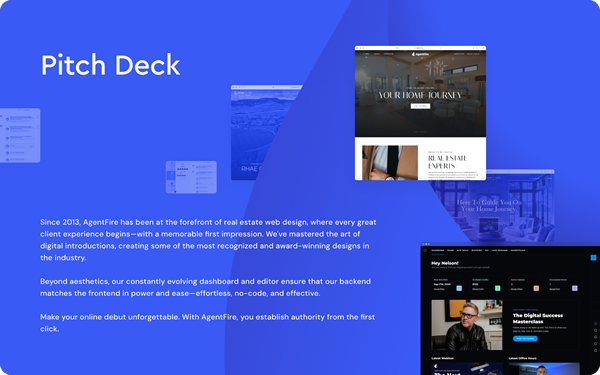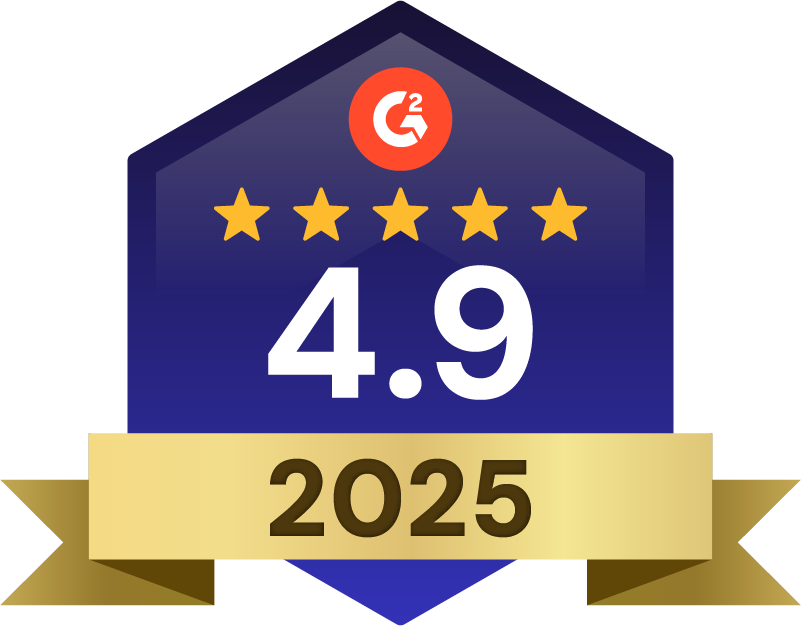Enhance your online presence and attract more clients with these 15 creative real estate blog topics. From market trends to home buying tips, these ideas will help you create valuable content that drives organic traffic and establishes your expertise.
Content Marketing
As a real estate professional, a strong online presence through a well-crafted real estate blog can make all the difference.
A blog not only highlights your expertise but also drives organic traffic to your website. Regularly sharing valuable, informative content helps establish you as a reliable resource in your local market, bringing in a steady stream of leads. In fact, 79% of companies with a blog reported a positive ROI on inbound marketing.
To jump-start your efforts, here’s a list of 15 real estate blog post ideas that are great for boosting organic traffic and engaging your audience. Whether it’s local market trends or home buying and selling tips, these topics will help you create a lively, informative blog that sets you apart from the crowd.

1. Local Market Trends and Analysis
Diving into monthly reports on current market changes positions you as a knowledgeable, reliable source of real estate information. Market analysis and forecasts are highly sought after topics for real estate blogs. Discussing what these shifts mean for buyers and sellers helps your audience make well-informed decisions.
Moreover, covering mortgage rate changes and their impact on local property values is crucial. This keeps your readers informed and shows your grasp of economic factors affecting the real estate market.
Success hinges on presenting information clearly and understandably; use visuals like charts and graphs to break down complex concepts.
2. Neighborhood Spotlights
Writing detailed posts about the neighborhoods in your market attracts potential buyers and highlights your expertise. Write articles about unique amenities, schools, parks, and the businesses that make each area special. Over 40% of all Google searches are local, emphasizing the importance of such content in real estate blogs.
Add a personal touch by sharing your experiences and insights about each neighborhood. This connection builds trust with your audience.

3. Home Buying and Selling Tips
Buying or selling a home is a major financial decision. As a real estate expert, your knowledge and experience can guide clients through this process.
Offer guides on navigating buying a home, covering topics like mortgage pre-approval, finding the right property, making an offer, and closing the deal. Break down each step and provide practical tips.
For sellers, provide strategies for preparing a home for sale, pricing it competitively, and attracting buyers. Address common mistakes and give guidance on avoiding them, tailored to your market.
By sharing this valuable information, you’ll attract potential clients and show your dedication to their success. Your blog will become a go-to resource for anyone looking to buy or sell a home in your area, cementing your reputation as a trusted expert.

4. Client Success Stories
Sharing real-life client success stories helps create a strong bond with potential clients. These narratives offer a peek into how you assist clients in reaching their real estate goals, showcasing your problem-solving skills and expertise along the way.
Focus on the specific obstacles your clients faced and the tailored strategies you used to address them. For example, you might recount how you helped a family secure their dream home even in a competitive market. Or perhaps, you could detail how you managed a smooth selling process for a client with tight deadlines, ensuring they got the best value for their home. These stories underscore your adaptability and resourcefulness in meeting diverse client needs.
Highlight the methods you employed, such as strategic marketing efforts or expert negotiation tactics, to lead clients to success. This showcases your ability to handle complex situations with precision and confidence.
Including client testimonials can amplify the impact of these success stories; direct quotes about your professionalism and dedication build credibility and trust. Potential clients will see that you not only deliver excellent results but also prioritize a client-focused experience.
Featuring client success stories on your blog illustrates the value you bring to the table. These narratives serve as compelling evidence of your skills and commitment, encouraging potential clients to imagine achieving similar success in their real estate journeys with your guidance.

5. Lifestyle Content Related to Real Estate
Engaging your audience by weaving lifestyle content into your real estate blog can create a richer experience. Not only does this add depth to your posts, but it also invites readers who are interested in the broader aspects of homeownership, positioning you as a knowledgeable and well-rounded expert.
Consider topics that resonate with homeowners—think about innovative home improvement projects, eco-friendly gardening practices, or stylish interior design tips. Discuss the latest trends in renovations, smart home technologies, or how to create functional outdoor spaces. Offering practical advice helps your audience enhance their living environments and enjoy their homes even more.
You might want to develop a series of posts about easy home updates that boost both comfort and value. Lay out straightforward steps, share handy tricks, and include illustrative images to keep your audience engaged. Or, you could focus on seasonal gardening tips, helping homeowners cultivate gardens that add charm to their property.
Interior design content is another area worth exploring. Share tips on color coordination, optimizing room layouts, or picking accent pieces that reflect personal style. Teaming up with local design experts can bring in fresh perspectives and strengthen your community connections.
Adding lifestyle topics to your blog demonstrates your commitment to helping clients create homes they love. This type of content not only attracts potential buyers but also keeps current homeowners interested, building a loyal following.
Moreover, lifestyle content can extend your reach beyond those actively looking for real estate services. By providing engaging and shareable insights, you increase the likelihood of your blog posts being found through search engines or social media. This heightened visibility can attract new visitors and expand your audience.
Sharing lifestyle content also lets you showcase your personality and interests. Including personal stories or insights helps build an authentic connection with your readers. This genuine approach fosters trust and sets you apart from other real estate professionals who might focus only on transactions.

6. Local Event Coverage
Highlighting local events on your blog is a great way to show that you’re an active part of the community. Real estate agents need to be seen as approachable and genuinely interested in the area and its people.
Attend community festivals, volunteer events, or neighborhood meet-ups and offer engaging recaps. Capture the essence of a bustling farmers market, the teamwork at a community service project, or the unity during a local celebration. Use lively language and colorful photos to bring these experiences to life.
Talking about these events not only showcases the community spirit but also helps potential clients imagine themselves as part of the neighborhood. This perspective can greatly influence their decision when considering a move.
Plus, covering local events opens up valuable networking opportunities. By mingling with event coordinators, small business owners, and influencers, you build relationships that could lead to collaborations or referrals. These connections are key to growing your professional network.
Reflect on your experiences at these events and share personal insights. Did you discover a new appreciation for the area? Meet someone who left a lasting impression? Find inspiration for new ideas? Sharing these thoughts helps readers connect with you on a deeper level.
Beyond blog posts, think about using social media to broadcast your event experiences. This not only extends your reach but also engages a wider audience. Encourage discussions by inviting followers to share their own event highlights, creating a sense of community around your presence.
Regularly covering local events will establish your blog as a go-to source for insights into the community. Readers will appreciate your commitment to showcasing the area’s energy and will be more likely to turn to you for real estate advice.

7. Frequently Asked Questions (FAQs)
Adding a dedicated FAQ section to your real estate blog can really boost its value. Think of it as a helpful resource; addressing common inquiries helps bridge the information gap for potential clients.
Start by pinpointing the most frequent questions you encounter from clients. Consider the stages of buying or selling that often bring about uncertainty or stress—these insights will become the backbone of your FAQ content.
Provide clear, concise responses that simplify complex real estate concepts. For instance, explain the escrow process, the importance of home inspections, or how contingencies can affect offers. This clarity empowers your readers to confidently navigate real estate transactions.
Drawing on real-world scenarios can strengthen your explanations. Share stories where thorough inspections uncovered potential issues, or describe how strategic handling of contingencies led to a successful sale. These narratives make your advice more relatable and grounded.
Adopt a friendly tone in your responses to build trust. Readers who appreciate this approachable style are more likely to see you as a reliable advisor, deepening their connection with your content.
Regular updates to your FAQs are a must; real estate is a dynamic field with evolving trends and regulations. Keeping up with these changes ensures your content remains relevant and useful to your audience.
Encourage your readers to submit their questions, creating a more interactive experience. This engagement not only enriches your content but also strengthens the community around your blog; readers feel valued when their concerns are addressed.
Ultimately, a strong FAQ section solidifies your reputation as a dependable resource. By proactively answering pressing questions, you show expertise and a commitment to client education, enhancing your blog’s appeal and attracting more organic traffic.

8. Comparative Market Analysis (CMA) Insights
Imagine having a tool that accurately evaluates property value—enter the Comparative Market Analysis. This essential resource looks at the finer points of the local market by comparing recently sold homes, active listings, and properties that didn’t sell.
Detailed CMA insights on your blog can be a game-changer for your audience; homeowners often struggle to pinpoint the right value for their property in a changing market. Explain how a CMA helps set a competitive price using solid data, and you’ll provide clarity.
Walk your readers through the key parts of a CMA report. Discuss how details like square footage, layout, lot size, and unique features impact a property’s market value. Adding charts and graphs can help break down complex data, making it easier to grasp.
Help your audience understand how to interpret CMA findings. Talk about choosing the most relevant comparables and adjusting for unique characteristics. This insight gives your readers the tools to make smart pricing choices.
Share real stories where CMAs led to success in your area; perhaps a seller priced their home just right after a thorough CMA, resulting in a quick sale. Or a buyer who used a CMA to make a winning offer, even in a competitive market.
These examples show the real benefits of CMAs and highlight your expertise. They also demonstrate to potential clients how your skills can help them succeed in their real estate goals.
Think about creating a blog series all about CMAs. Start with an introduction to what they are and why they’re useful, then break down each component. Wrap it up with a deep dive into a full CMA report, showcasing your method and insights.
Sharing this kind of content establishes you as a trusted expert in property valuation. Clients will appreciate your commitment to educating them and are more likely to rely on you for their real estate needs.

9. Seasonal Maintenance Checklists
Sharing seasonal maintenance checklists on your blog is a great way to provide added value that helps homeowners maintain their dream homes.
These checklists serve as handy guides, helping homeowners remember important tasks to keep their properties in top shape. For instance, when fall rolls around, focus on tasks like cleaning gutters; in spring, emphasize checking HVAC systems.
Consider structuring your blog series to spotlight a different season in each post. Winter might include tasks like insulating pipes and checking heating systems; spring posts could cover roof inspections and getting the garden ready.
During summer, talk about maintaining outdoor areas and improving energy efficiency. As fall approaches, guide your readers on cleaning chimneys and securing weatherstripping to prepare for the colder months.
It’s not just about listing tasks—explain the importance of each one. Show how maintaining gutters can prevent costly water damage or how sealing drafts can improve energy efficiency. These insights confirm your expertise and highlight the benefits of regular maintenance.
Adding personal experiences can make your content more relatable. Share stories about how proactive maintenance has preserved property value or how neglect led to expensive repairs. These anecdotes make your advice practical and memorable.
To enhance your checklists, offer downloadable versions or provide links to reputable resources. Recommend trusted products for each task or share tutorials for complex projects so homeowners have everything they need.
Providing seasonal maintenance checklists shows your dedication to clients’ long-term success. This type of valuable content positions you as a reliable resource for homeowners, potentially increasing client loyalty and attracting new business.
These posts can appeal to a wide audience, from first-time buyers to seasoned homeowners. As they explore the comprehensive resources on your blog, they’ll be more likely to seek your expertise for future real estate needs.
Think about forming partnerships with local professionals, like HVAC experts or landscapers, to offer exclusive deals to your readers. Such collaborations can create mutually beneficial relationships and expand your network.
Offering actionable advice through these checklists demonstrates your commitment to client support, helping you stand out in a competitive market and fostering a loyal client base.

10. Home Renovation Projects
Homeowners love the idea of upgrading their properties to boost market value and aesthetic appeal. As a skilled real estate professional, you can offer valuable advice on renovation projects that make a real difference, solidifying your role as a trusted advisor.
Focus on renovations that are popular in your local market. This might involve a kitchen makeover with top-notch appliances and quartz countertops or turning a simple bathroom into a spa-like oasis. Talk about features and finishes that buyers in your area are actively seeking.
Offer a range of renovation ideas to fit different budgets and styles. For those looking to make cost-effective changes, suggest repainting rooms, upgrading to energy-efficient lighting, or enhancing curb appeal with landscaping. For clients considering bigger changes, discuss the benefits of adding space with an attic conversion or creating an open floor plan.
Explain how each renovation can boost property value; use market-specific data or examples to show the expected return on investment. Clients will appreciate learning about the financial gains from their home improvement decisions.
Include before-and-after photos to clearly show the dramatic changes renovations can bring. Seeing a dull living room turned into a lively gathering space or a neglected backyard transformed into a welcoming patio can inspire homeowners to start their own projects.
Share stories of clients who have completed successful renovations; this adds a personal touch to your blog. Conduct interviews about their experiences, challenges they faced, and their satisfaction with their home’s new look. These stories make your content more relatable and credible.
Provide practical advice on planning and carrying out renovations. Discuss how to set realistic budgets, find reliable contractors, and manage timelines effectively. Highlight which projects are suitable for DIY lovers and which need professional help.
Enhance your content with a detailed renovation checklist or a comprehensive guide for a specific project. Break down the process into clear steps and offer recommendations for materials or local service providers. These resources showcase your expertise and make the renovation process easier for clients.
Renovation content appeals to a broad audience, from homeowners seeking upgrades to potential buyers interested in turnkey homes; this is where you can shine. By offering valuable insights and inspiration, you can attract more visitors to your blog and establish your reputation as a go-to real estate resource.
Sharing renovation strategies and insights highlights your knowledge of what makes a property desirable in your market. This expertise can lead to more opportunities to help buyers and sellers who trust your professional judgment and appreciate your industry skills.

11. Investment Opportunities
Real estate investing offers a solid path for building wealth, and as an industry expert, you can guide new investors effectively. Your expertise will attract people eager to explore this profitable field.
Start by highlighting the perks of real estate investing: the chance for steady cash flow, asset value appreciation, and tax benefits. Explain how rental properties or house flipping can become reliable income sources that align with long-term financial goals.
Look into the variety of investment properties available in your area—single-family homes, multi-unit buildings, and commercial spaces like offices or retail properties. Give a detailed overview of the unique features and expected returns of each investment type.
For those interested in rental properties, offer advice on spotting promising investments, calculating rental yields, and managing tenant relationships. Discuss how location, property condition, and market demand play a role in shaping a successful rental business.
In areas suitable for house flipping, provide a step-by-step guide to starting such projects. Talk about finding undervalued properties, budgeting for renovations, and setting realistic timelines. Share stories of local investors who have turned properties around for profit.
Introduce readers to commercial real estate investing, focusing on longer lease terms, increased income opportunities, and tenant quality. Outline different commercial property types and what to consider when making smart investment decisions.
No matter the investment, emphasize the importance of thorough research and risk management. Offer tips for analyzing market trends, evaluating property values, and creating solid investment plans. Highlight how expert advice can help navigate the complexities of real estate investing.
Think about creating a series of blog posts that go deeper into each type of investment. Include case studies of successful local deals, detailing strategies used and lessons learned. These real-world stories can make the investment process clearer and inspire your readers to make informed decisions.
By sharing practical advice and expert guidance on real estate investing, you position yourself as a reliable and knowledgeable resource. This expertise will attract potential investors who are likely to seek your services as they enter the real estate market.

12. Home Financing Options
Navigating home financing can be tough, especially for first-time buyers. As a real estate professional, you’re there to make this process easier by providing your clients with clear and personalized advice on their financial choices.
Your blog can become a go-to resource for exploring the various financing paths available to homebuyers. Discuss everything from traditional mortgages to specialized options like FHA and VA loans; include a straightforward breakdown of each loan’s features, benefits, and eligibility criteria so buyers can make confident decisions.
It’s important to make financial jargon simple when talking about financing; break down terms like interest rates, down payments, and credit scores into easy-to-understand language. Use relatable examples to show how these factors impact the buying process and the long-term cost of owning a home.
Exploring mortgage structures—such as fixed-rate and adjustable-rate loans—can also be helpful. Explain how different loan durations, like 15 or 30 years, affect monthly payments and total interest; clear explanations empower readers to make smart decisions about their loan choices.
Recognize that each buyer’s financial situation is unique, so offering insights tailored to different buyer profiles is key. Highlight how first-time buyers might benefit from FHA loans with minimal down payments, while veterans could take advantage of VA loans for better terms.
Sharing stories from clients where you’ve successfully tackled financing challenges can make a big impact. Talk about how you’ve helped clients improve credit scores or secure down payment assistance, showcasing your problem-solving skills and expertise.
Think about creating a blog series that dives into specific financing topics. One post could explain mortgage pre-approval, another could compare loan types, and a third might discuss how interest rates impact affordability. Breaking these complex topics into manageable parts helps readers understand them better.
Encourage collaboration with trusted professionals like mortgage brokers. Give advice on choosing the right lender and what to ask when comparing loans; this positions you as a valuable ally in your clients’ financial journey.
Offering solid financing content builds trust and credibility; showing your deep understanding of this important part of home buying attracts potential clients who are looking for informed, supportive guidance in their real estate journey.

13. Real Estate Technology Trends
Right now, technology is quickly reshaping how real estate works, bringing in fresh solutions that make things better for both agents and clients. If you’re a forward-thinking real estate professional, keeping up with these changes helps you stand out as a leader.
Your blog is a great place to talk about the latest tools and platforms that make buying and selling easier. Virtual tours, for example, have become a major player in property marketing; they let potential buyers explore homes in-depth without stepping inside. These tours provide a more immersive view of the property, giving buyers a better feel for the space and layout than photos ever could.
Virtual tours not only make things more efficient by cutting down on the number of in-person viewings needed but also help clients make faster, more informed choices. Share tips on creating standout virtual tours that highlight a property’s best features, so they catch the eye of potential buyers.
Moving on to online documentation and e-signature platforms: these tools simplify the transaction process by reducing paperwork and making remote interactions smoother. They’re now a must-have for handling contracts and other important documents, speeding up the closing process.
Show how you’ve used these technologies to provide top-notch service, even when dealing with clients far away or in different time zones. It shows your knack for using tech to tackle modern real estate challenges.
It’s also important to highlight the role of mobile-responsive websites and user-friendly apps, especially since mobile searches are so common now. A well-designed mobile site can significantly boost client interaction and loyalty, offering a handy way to check out property information anytime, anywhere.
Talk about the steps you’ve taken to make your website mobile-friendly and how you’ve incorporated apps to improve the client experience. This not only keeps you ahead of the game but also ensures you meet the expectations of today’s tech-savvy clients.
You might also want to mention new technologies like blockchain and artificial intelligence, which could change how real estate deals are done. Break these complex ideas into simple insights to show you’re up-to-date with future trends and ready to adapt.
Consider writing a series of blog posts that delve into each tech trend, providing practical tips and real-world examples. This strategy reinforces your image as a forward-thinking agent who uses technology to benefit clients.
By focusing on these tech trends in real estate, you offer readers valuable information and set yourself apart from others. Clients will appreciate your dedication to innovation and trust you to guide them through the ever-changing real estate market with confidence.

14. Sustainable Living Tips
More and more, homeowners are focusing on eco-friendly and sustainable living practices. As a real estate expert, you have the chance to guide clients who want to make their homes more environmentally friendly.
Your blog can be an excellent place to share advice on how to enhance home sustainability. Start by discussing the benefits of adopting green practices—like cutting down utility costs, reducing environmental impact, and possibly increasing property value. These reasons can motivate readers to consider sustainable options.
Solar energy is often a hot topic when talking about sustainable living. Make the process of installing solar panels easy to understand, and emphasize the long-term financial savings they offer. You could share stories of local homes that have successfully switched to solar power, noting their reduced energy usage and cost savings.
Also, talk about the financial perks available for adopting solar energy, such as tax benefits and rebates; this information enriches your content and helps readers make informed decisions.
Eco-friendly building materials open another path to sustainability. Think about materials like cork flooring or reclaimed wood, which support a greener lifestyle. Describe their benefits, such as the renewability of cork or the appealing look of reclaimed wood.
Guide readers on how to use these materials in home renovations or new constructions. Examples of local properties that have used these materials can inspire readers considering green renovations.
Water conservation is another key part of sustainable living. Offer tips on installing water-efficient fixtures like aerated faucets and smart leak detectors. Explain how these can significantly reduce water use without losing functionality.
Encourage readers to try landscaping practices that conserve water, like xeriscaping with drought-resistant plants or using rainwater harvesting systems. These methods save water and enhance the property’s aesthetics.
You might consider writing a series of blog posts focused on specific aspects of sustainable living. Topics could vary from energy-efficient home appliances to sustainable insulation materials. Breaking these down into focused posts helps readers gradually adopt sustainable practices.
Throughout your blog, highlight your role as a knowledgeable partner in this journey. Share your expertise in finding eco-friendly properties or connecting clients with sustainable building specialists. This positions you as a trusted advisor for those interested in sustainable living.
Offering practical advice and real-life examples makes your blog a valuable resource for those looking to live sustainably. Readers will appreciate your commitment to helping them create efficient, eco-friendly homes, which reinforces their trust in your expertise and makes it more likely they’ll seek your real estate guidance.

15. Your Personal Journey in Real Estate
When you share your personal journey as a real estate professional, it allows you to connect deeply with your audience; it’s a chance to bring out the human stories that have fueled your passion and expertise in this field.
Think about those defining moments that have shaped your career path. You might remember a challenging deal that sharpened your negotiation skills or a memorable client interaction that reaffirmed your dedication to customer service. These stories give a glimpse into the real situations that have contributed to your professional growth.
Talk about the obstacles you’ve overcome. Maybe you navigated a tough market or worked hard to build your reputation. Sharing these experiences shows your perseverance and flexibility—traits that reassure clients of your capability and commitment.
Reflect on the wisdom you’ve picked up throughout your career. These lessons could range from mastering effective client communication to keeping up with market trends. Sharing these thoughts provides readers with valuable knowledge they can apply to their own endeavors.
Share the rewarding parts of your work that keep you excited. Talk about the joy of helping a family find their dream home or seeing a community come back to life. These positive experiences highlight your passion for real estate and your dedication to making a difference.
Throughout your story, emphasize the core values that guide your practice. Whether it’s a commitment to ethical dealings, a personalized approach to client interactions, or involvement in the community, these elements reflect the heart of your business.
As you recount your journey, think about how other real estate professionals might learn from your experiences. Your journey can offer practical case studies, providing guidance on building a successful career in the industry.
Perhaps your personal background influences your approach to real estate. Maybe your own home-buying experiences inspire your empathetic approach, or your strong ties to the community drive your commitment to local development. These personal insights add depth and authenticity to your story.
Keep the tone of your personal journey blog posts sincere and engaging. Write as if you’re sharing with a trusted colleague, talking about the highs and lows of your career with honesty and warmth. This conversational style fosters a genuine connection with your audience, establishing the trust and rapport that are so important in real estate.
Offering readers a glimpse into your real estate journey creates a meaningful connection; your stories can educate and inspire, showcasing the unique insights and values you bring to your work. Sharing your journey invites readers to see you not just as a real estate expert but as a relatable and dependable partner in their own real estate endeavors.
As you explore these real estate blog post ideas, remember that creating valuable content is key to attracting and engaging your target audience. By consistently sharing informative and relevant posts, you can establish yourself as a trusted resource in your local market and drive more organic traffic to your website. If you’re ready to take your real estate website to the next level, book a demo with us today and see how we can help you achieve your goals.






